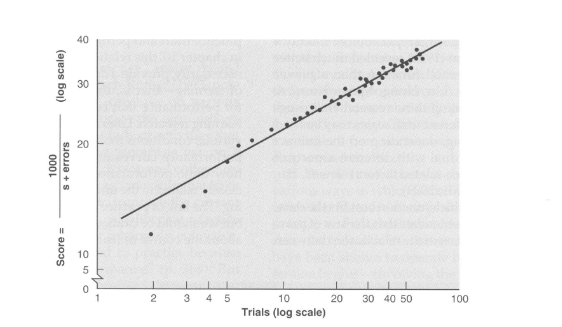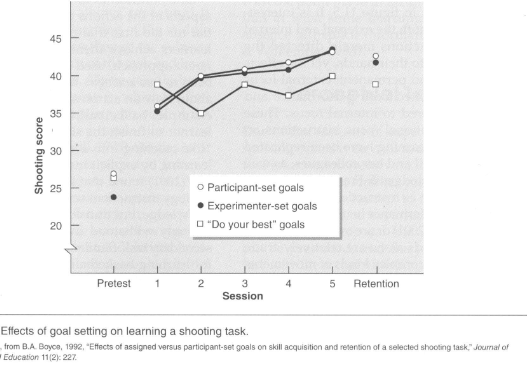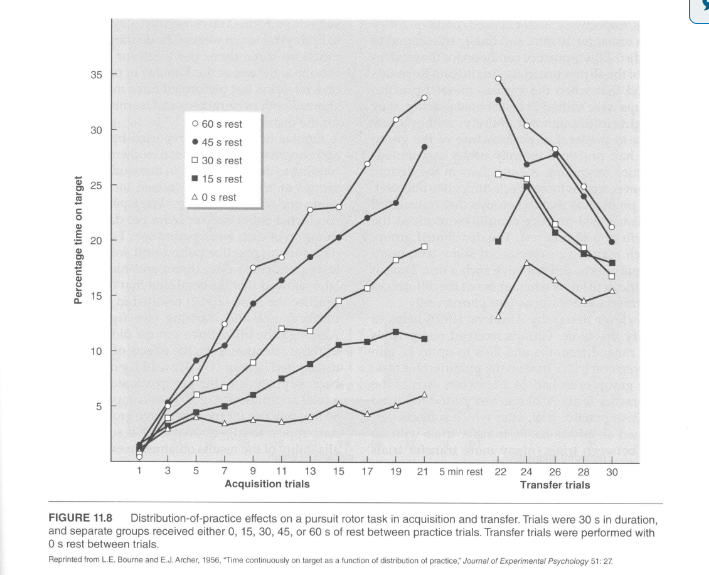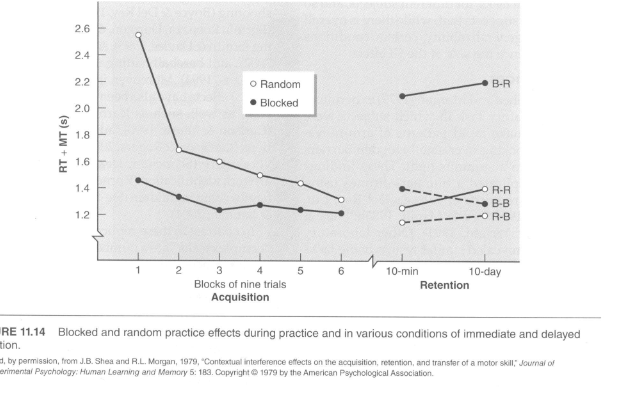Conditions of Practice
1/43
There's no tags or description
Looks like no tags are added yet.
Name | Mastery | Learn | Test | Matching | Spaced |
|---|
No study sessions yet.
44 Terms
“Law of Practice”
The amount of practice: the variable that stands at the top in terms of importance compared to others
More learning occurs with more practice trials
Performance with practice in the beginning are on average generally large and rapid at first
Gets smaller as practice continues
Curves of Performance Accompanying Variable of Practice
Performance curves usually negatively accelerated functions of practice
eg. rate of improvement changes toward zero as practice continues due to athlete reaching the limits of their ability (slowing down)
Power function Between Performance and Practice Trials
Expressed as: T = a P-b = a / PB
T = time to complete an action
a and b are constants
As practice increases and P becomes larger, ratio a/P decreases
This results in smaller time to complete action T
The larger the constant b, the decrease in practice falls drastically
Power Law of Practice
Practice on numerous tasks with widely differing movement measurement, goals, and measures of performance tend to follow the logarithmic function above
Example: Drawing of the Tracing Instrument (Snoddy, 1926) → First to show this
Subjects drew figures while only viewing mirror image of their hand
How fast one went around, but also how much they touched the edges
Practice over 100 days (one trial/day)
Saw nonlinear improvement
Eventually hit a ceiling in performance
In 100 trials, saw improvement pretty quickly, but how many more trials does one need to see that same amount of improvement? (1000 more trials?)
Therefore, theoretically we shouldn’t see a ceiling at all and strive improvement, but qualities such as aging hinders this

Off-task Practice Considerations
Generally applied when learner is not actively engaged in physical performance
1) Motivation for Learning
2) Verbal Information
3) Perceptual Learning
4) Observational Learning
5) Mental Practice
Motivation for Learning
If learner perceives task as meaningless or undesirable → less intuition to try and learn task
Therefore, making the task seem important should be a goal in practice
In many cases, it may not just be the motivation to perform well at certain sport/activity, but why it would be useful to possess a certain skill within
eg. in american football, tackling head-on is fine fine when men are young, but once that time in life comes where the it takes the body longer to recover or more prone to injury, less violent recreational skills might be preferred so one may continue to play
Goat Setting (Part of Motivation)
Motivation technique that involves performers trying to attain goals that are set before they begin practice
Most appealing and used goal in all type of daily activities: do your best goal
Common, but not as effective compared to other goals
“Difficult” goals as proposed by Locke & Latham (1985) suggest that they produce stronger performance than no ogals, or simply doing one’s best
Proposed four advantages of setting difficult goals:
(1) Focus one’s activities
(2) Help to regulate effort
(3) Help maintain vigilance in attempting to reach goals
(4) Serve as referent against which achievement can be compared
Locke and Latham (1985) “difficult” goals theory not consistently supported although
Other research also find short term mixed in with long term goal effective, as well as absolute goals of moderate difficulty
Overall, specific goal-setting procedures suggested to be beneficial for effects on both performance and learning

Verbal Information
Assuming performer is motivated to learn, many believe giving information about the task beforehand is important
1) Instructional Set (Part of Verbal Information)
Common practice of verbal instructions by teachers/instructors to give students an orientation to a new skill
Instructions can provide useful and important information about the movement itself
Gives an overall “idea” or image of the movement that can serve as representation for the first attempt
eg. initial position of limbs, stance, what to watch, listen for, or do
Can be good for development of error-detection capabilities
eg. giving an instruction to student to see if arm is straight after the movement
2) Focus of Attention (Part of Verbal Information)
Be able to recognize that words alone are not enough to describe especially complicated movements that a learner may be trying to achieve
eg. pole vault
Only global, most general aspect of the intended movement are going to transmitted through verbal instructions
One may forget or not be able to completely visualize the task (more prominent in children)
Therefore solutions implemented are:
Focus attention first on actions that are absolutely essential in movement
Makes sure learners achieve these early on in practice
The use of analogies
eg. when finishing a basketball shot, hand position should look “like reaching into a cookie jar”
Learning Without Awareness (Part of Visual Information)
Some research suggest that learning of some tasks can occur without verbal instruction (learners oblivious to components of the task)
eg. study by Wicken & Pew (1974)
A trial comprised of three 20 secs segments
Subjects practiced a pursuit tracking task, having to move a lever in order to try to match a perceptual input signal on a computer monitor
Total of 24 trials/session; 16 days of practice
Perceptual signals of the 1st and 3rd perceptual signal always different, but middle (2nd) always remained the same each time
Now subjects were unaware of this yet improvements on the middle segment were greater and occured much faster than the random segments
Knowledge of Mechanical Principles (Part of Visual Information)
Suggests that it is not always necessary for learners to know the mechanical properties underlying a task/movement
Thus, some learning is able to occur without explicit information (eg. instructional verbal information that tries to clearly outline how to perform a particular task)
eg. learning without awareness
3) Perceptual Learning
Exposing the learner to the environmental stimuli that will be experienced in the task
Allows for temporal and spatial regularities to be presented, and the performance of the task with the actual stimuli may be more effective when performer begins to respond to environmental stimuli physically
eg. a race car driver walking through a road racing course before driving it
4) Observational Learning
Specific kind of perceptual learning that uses modeling such as demonstrating the skill or showing videos/photos of skilled performers, so that learners can observe the elements of the action directly
What can be Learned Through Observational Learning?
Movement strategies
Martens, Burwitz & Zuckerman (1976)
Try to move ball rolling on top of two rods by varying distance between the rods
Two strategies for success modeled:
(1) “Creeping” strategy
Distance between rods adjusted slowly in order to move ball (Consistent but moderately successful results)
(2) “Ballistic” strategy
Involved a rapid and more violent adjustment of the rods (Not as consistent, but when scores are high, they can be very high) → This gambling bruh
Observers (visually) then when given the opportunity mimicked these two strategies to perform the task (They know it works)
Timing
eg. Zelaznik and colleagues
One group of subjects provided with the recorded sounds of another subject making a correct timing movement (auditory) prior to any practice
Group who had listened to the sounds performed the timed movement more accurately than the group who didn’t
“Listening group” could even improve slightly in the task without any knowledge of the results
Model Skill Level (Part of Observational Learning)
Assumptions that the use of video that provide sport instruction that highly skilled performers are more effective than unskilled models
Not necessarily true
Points towards when people observe unskilled models learn a motor task
In fact, a learning model can result in stronger observational learning than an expert model in some circumstances
Adams (1986)
Found that observation alone was insufficient for learning task at hand
However considerable learning can be observed if the model’s feedback from the experimenter (knowledge of results, KR) was also presented to the observer
Observer can gain information:
From the model about the movement performed (visual and auditory)
From the augmented feedback presented to the model
From seeing the success of the model’s attempt to use that feedback on the next performance of the tasks
This way, observer not only benefit from “observing” , but also from observing the processing operation of the model in the attempt to improve performance
Increasingly important as difficulty of task rises
McCullagh & Caird (1990)
One group had repeated exposures to a tape of a perfect execution of the timing goal
Two other groups watched a tape of model was learning the task
One received the model’s KR; one did not
Results found that the largest effects were found in those who observed model and also received the model KR (open squares on graph)
What does this say about observational learning?
All in all, skill level may not be as important as we think, but rather why of information is being demonstrated → errors or perfect templates of an action
We learn more from observing mistakes than we do from correct performances!!!

Scheduling Observations (Part of Observational Learning)
Scheduling of observation and physical practice has the advantage of engaging the learner more in the active problem-solving process of learning
More beneficial than demonstrations being presented prior to physical practice
Thus, interleaving information gained from off-task observation with on-task practice appears to optimize the benefits gained from observations
5) Mental Practice
Performance of a task is mentally rehearsed, often using imagery techniques, in the absence of overt physical practice
Cognitive rehearsal: one visualizes themselves going through the actions, but don’t actually do them
On-task Practice Conditions
1) Distribution of Practice
2) Variability of Practice
3) Scheduling of Practice (Contextual Interference)
4) Part vs. Whole Practice
5) Guidance
1) Distribution of Practice
The scheduling of period of work (i.e., time spent in actual practice) and rest (i.e., time not practicing the task)
Does frequency and length of rest periods have an effect on learning the skills being practiced in the work period?
Simply, what is the best practice distribution?
“Massed” and “Distributed” Practice
“Massed” Practice
Running work periods very close together with either no rest at all or very brief rest interval between work periods (Taha ah)
“Distributed” Practice
Spacing periods of work apart with longer intervals of rest
*These terms must be considered relative to the context of other conditions with any particular experiment and relative to the context of other experiments
Distribution-of-Practice Effects on Performance
Research found that: given constant periods of work, short rest periods degrade performance relative to performance with longer rest periods
Distribution-of-Practice Effects on Learning
Practice with little or no rest would likely cause muscular fatigue to develop
How much fall in performance can be attributed to learning?
See Bourne & Archer (1956)
Gave subjects a 5 min rest period following last acquisition trial
After rest period, subjects performed common transfer test in which groups were required to perform all trials with 0 secs of rest between 30 secs work periods
Idea behind this is that if muscular fatigue was responsible for all the difference between groups during the acquisition trials, then groups should be similar in performance once fatigue cooled down
This was NOT the case (See graph)
Those who had rest periods during acquisition trials still performed better than the group with no rest regardless of all groups having 0 secs of rest in transfer trials

Effects of Practice Distribution Overall
Strong indication that practice distribution has large effects on temporary performance levels and relatively permanent influences on learning
Total Practice Time (Part of Distribution of Practice)
May not seem beneficial for learning to mass trials in a practice session
But… there is another important variable that co-exists with massing:
Total time involved in practice
Group who receive massed practice will have a shorter total practice than an equivalent group with distributed practice
In terms of practice distribution, there will always be trade-off
Distributed results in most learning per time in training, but requires the most time
Massed results in reduced benefits [poorer acquisition and retention (Baddeley & Longman (1978)], but requires the least total time
Thus, what is most effective for learning, may not always be the most efficient, at least when looking at how much time one has to practice a skill and so on
![<ul><li><p>May not seem beneficial for learning to mass trials in a practice session</p><ul><li><p>But… there is another important variable that co-exists with massing:</p><ul><li><p>Total <strong>time</strong> involved in practice</p></li><li><p>Group who receive massed practice will have a shorter total practice than an equivalent group with distributed practice</p></li></ul></li><li><p>In terms of practice distribution, there will always be <strong>trade-off</strong></p><ul><li><p>Distributed results in most learning per time in training, but requires the most time</p></li><li><p>Massed results in reduced benefits [poorer acquisition and retention (Baddeley & Longman (1978)], but requires the least total time</p><ul><li><p>Thus, what is most<strong> effective</strong> for learning, may not always be the most <strong>efficient</strong>, at least when looking at how much time one has to practice a skill and so on</p></li></ul></li></ul></li></ul></li></ul><p></p>](https://knowt-user-attachments.s3.amazonaws.com/5254506a-f770-410b-8755-385a9506f7ab.png)
Safety Issues (Part of Distribution of Practice)
Massed practice has higher likelihood of risk of injury dependent on the intensity if the task
Therefore extra caution when designing training regimens in situations where factors such as fatigue can put the learner at risk
More fatigue → more probability for error hence hurting themselves potentially
Discrete Tasks (Part of Distribution of Practice)
Research find that effects of distributed practice on performance and learning in continuous and discrete tasks might have more similarities than previously thought
2) Variability of Practice
Findings indicate that:
Practice variability can actually facilitate better retention that just constant practice
Variable practice seems to increase generalizability (important criterion for motor learning)
NOTE: All in all, when adults are subjects, there is reasonably strong belief that increased practice variability is beneficial for learning (as measured in novel transfer tests), and that there is not evidence for variable practice to be detrimental
Once again, this results in greater learning and generalizability
But… there are issues that complicate this situation (Covered in next few flashcards)
Age of the Learner [Issue Complication #1 for Practice Variability (PV)]
Shapiro & Schmidt (1982)
Highlighted that in almost every study, children showed greater advantage practicing under variable conditions compared to constant practice
Kerr & Booth (1978)
Found surprising results of rather than the novel task itself, practicing variations similar to the novel task was much more effective
Therefore, practice variability is a powerful variable in childens’s motor learning
Even more effective in children than for adults because they have considerably “more to learn” than adults
Nature of the Task (Issue Complication #2 for PV)
Shea, Lai, Wright, Immink & Black (2001)
Found that relative timing of a closed task learnt better with constant practice
In contrast, learning absolute timing of the task learnt better under variable practice
These findings support the idea that some aspects of the same task may be learned effectively through constant practice conditions while other aspects through variable practice conditions
Scheduling Variable Practice (Issue Complication #3 for PV)
Lee & Colleagues (1985)
Say that for variable practice to be most effectively utilized, the order should be randomized, rather than blocked
3) Contextual Interference
Focuses on practicing a number of tasks variations (randomized), compared to practice on only one task variation (blocked)
Blocked vs. Random Practice
Shea & Morgan study influenced considerably by the ideas of William Battig
Together their work has made substantial impact on research in motor learning and practical application to real-world skills
Main Issue:
Found that variables that made the organization of practice more “difficult” during acquisition degraded performance during acquisition
But… made performance in retention and transfer tests more effective
There may be decrements in practice, but made learning of the tasks more effective
Taken a step further when Shea & Morgan (1979) find that high level of contextual interference by randomized conditions being practiced generated a learning advantage as seen in retention and transfer tests
Contextual Interference (as described by Battig)
“Interference generated due to the context in which the skills were being practiced”
William Battig & Contextual Interference
Battig’s Findings: Difficult practice (e.g., multitasking or switching tasks) impairs immediate performance but improves retention and transfer to new tasks.
Sources of Interference:
Order of Practice – Switching tasks causes more interference than blocked practice.
Task Similarity – Similar tasks create higher interference than distinct tasks.
Shea & Morgan (1979): Applied Battig’s theory to motor skills.
Blocked practice: Good for immediate performance.
Random practice: Poor during learning but better for long-term retention and transfer.
These ideas revolutionized motor learning by showing that effortful practice leads to better skill development.
Key Findings of Shea & Morgan (1979)
Key Findings
Acquisition (Practice Phase):
Blocked practice led to better performance during practice (e.g., participants improved faster).
Random practice caused participants to struggle more and perform worse during the practice phase.
Retention Tests (10 min and 10 days):
Random Practice (R-R Group): Outperformed those who trained with blocked practice, even when tested under random conditions.
Blocked Practice (B-R Group): Performed poorly during random retention tests, despite their earlier practice advantage.
Retention under Blocked Conditions: Even when tested in blocked sequences, participants who had practiced randomly (R-B) outperformed those with blocked practice (B-B).
Transfer to Novel Tasks:
Similar results—random practice enhanced participants' ability to adapt and transfer their skills to new movement patterns.
Conclusion and Implications
Blocked Practice: Leads to short-term gains but poor retention and adaptability.
Random Practice: Though harder during acquisition, it promotes better retention and skill transfer over time.
Contextual Interference Effect (CI Effect): The study supports Battig’s theory that interference during practice enhances long-term learning by forcing learners to engage in more effortful processing.
Applications:
Coaches, teachers, and therapists can improve real-world performance by incorporating random practice into training, even though it makes learning harder initially.

Generaliazbility of Contextual-Interference Effects
Studies finds that:
Random practice has almost always been found to be as beneficial as, if not superior to, blocked practice for learning
Even highly skilled athletes benefited from practice
eg. Hall & colleagues (1994)
College-level baseball players experienced blocked or random order of pitches during batting practice (2 extra session per week for six weeks)
(Suggest) that it may be possible to reduce the acquisition performance decrement normally seen with random practice without sacrificing the long-term benefit as a consequence
Combing positive effect in acquisition performance of a blocked practice with the beneficial learning effect of a random practice schedule
Hypotheses on Contextual-Interference Effects
Elaborative Processing Hypothesis
Forgetting & Reconstruction Hypothesis
Other Hypotheses
Elaborative Processing Hypothesis
Random practice promotes deeper mental processing by forcing learners to compare and contrast tasks compared to blocked practice
Each trial involves a different task, requiring unique preparation and evaluation, making tasks more distinct and memorable.
Good for learning in the long-term
Forgetting and Reconstruction Hypothesis
Reconstruction Hypothesis (Lee & Magill, 1983, 1985)
Theory proposes that the action planning before each practice trial is influenced by previous trials
In random practice, plans for tasks must be repeatedly constructed and reconstructed, benefitting learning when brain is engaged in reconstructive processing
Research suggests that random practice promotes learning by inducing short term forgetting whereas blocked practice, by reducing this demand, limits constructive processing
Random practice requires more than blocked practice of:
Attentional resources
Motor programming time
Blocked practice is more effective when only one GMP is involved, especially for learning relative timing
When Forgetting Improves Remembering
The Spacing Effect:
Experiments on verbal memory, where subjects are asked to study a list of words and recall them later, show that words repeated with long intervals (long lags) between repetitions are better recalled than those repeated with short or no intervals.
This phenomenon is called the spacing effect and suggests that the time between repetitions plays a crucial role in enhancing long-term memory.
Jacoby’s Explanation:
Larry Jacoby proposed that forgetting aids memory because it forces the learner to fully reprocess the material when it is presented again.
If information is still fresh in memory from a previous presentation, the learner doesn't engage in as much cognitive effort to process it the next time.
On the other hand, if the information has been forgotten, more thorough processing is required upon encountering it again, which strengthens memory for that information.
Problem-Solving Analogy:
Jacoby likened processing information to solving a problem. If the solution (or memory) is readily available, the problem can be solved quickly without reprocessing. However, if the solution has been forgotten, it requires full mental effort to solve it again, thereby improving retention.
His key idea is that memory improves when solutions (i.e., the previous processing of information) are forgotten because this prompts a more in-depth processing when re-encountered.
Other Hypotheses
Wulf and Schmidt (1994a)
Random practice may benefit learning by making response feedback (KR) less useful, which can be a good learning strategy
"Difficulty" Hypothesis
CI effects may arise from a difficulty that is caused by the interaction between the learner, the task, and the environment, rather than purely cognitive factors
Connectionist Models
Some researchers have explained the CI effect using connectionist models, which describe learning as a process of strengthening connections between neural units
Two Caveats
Misjudgment of Learning:
Simon and Bjork (2001, 2002) found that individuals in blocked practice tend to overestimate their retention abilities, mistaking immediate performance success for learning. This highlights a persistent problem where performance effects are often confused with true learning (Bjork, 1994).
This misjudgment can make it difficult to convince learners, instructors, and trainers to adopt practice methods, like random practice, which seem less effective during training but yield better long-term learning outcomes.
Self-Regulated Practice Schedules:
When learners are allowed to self-regulate their practice schedules, they tend to choose different approaches: some prefer blocked practice, others random, while some opt for a progression from blocked to random practice (Keetch & Lee, 2007; Wu, 2007).
Regardless of the chosen method, self-regulation boosts learning compared to externally imposed practice schedules.
This suggests that allowing learners to tailor their practice schedules to their own needs might optimize learning, especially in variable task environments.
Adaptive Practice Schedules:
Recent research has explored adaptive, learner-contingent schedules (Huang, Shadmehr, & Diedrichson, 2008; Choi et al., 2008), which adjust to the learner’s needs. These schedules may be more successful when aligned with long-term learning goals rather than immediate performance gains.